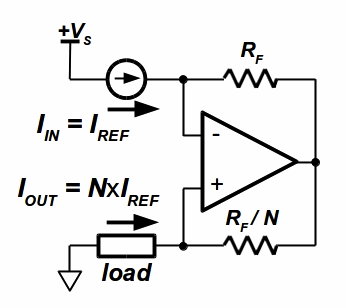This Design Idea mates a precision current source IC with precision difference amp chips to create a programmable current source or sink.
The resistor-programmable current source/sink in Figure 1 illustrates the basic topology, taking advantage of tightly matched on-chip resistor ratios instead of relying on absolute tolerances.
The IIN current source gives rise to a reference voltage across Rf at the op-amp inverting input. The same potential is found across the Rf /N resistor, so that an output current of N × IIN will be generated.
Despite a decreased compliance voltage due to the absence of direct connections to the op-amp inputs, the LT1991/5/6 is used as a single chip current divider. Figure 2 shows an example configuration, with a REF200 as the input current reference. Due to the high value of the internal feedback resistor connected to the op-amp inverting input (450 kΩ), a parallel connection with the 450/9 kΩ resistor is necessary to avoid op-amp output saturation induced by the injected IIN current. The negative feedback resistance is thus equal to 450/10 kΩ, or 45 kΩ.
Given the 450 kΩ positive feedback resistor, N for Figure 2 is 0.1, yielding an output sink current of 10 μA. Different values of the output current can be obtained using the other available internal resistors. If an output source current is needed, reverse the connections to the REF200 IC and connect it .
The dotted lines in Figures 2 & 3 illustrate how unused internal resistors can be paralleled to reduce voltage drops in the reference and load paths.
Figure 3 shows a similar application based on the LT1995 chip and used to increase the output current, in this case, summing the currents from the two sections of the REF200 and multiplying by a factor of five.
For more detail: Precision programmable current source uses two ICs

